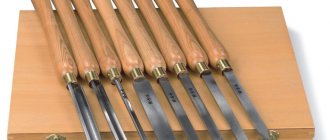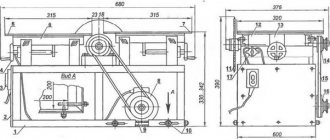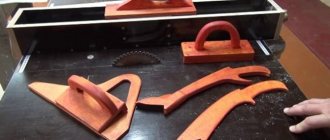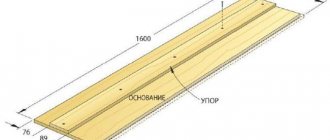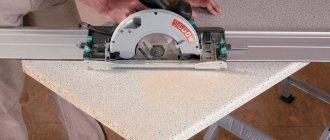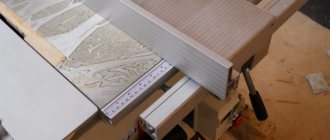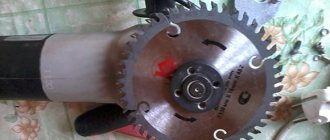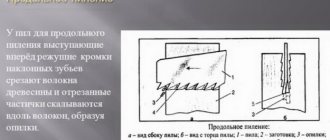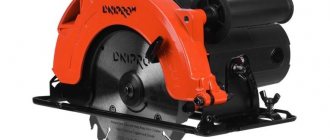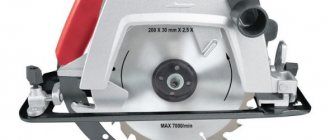Home craftsmen know that there is no such thing as too many tools. You need everything - from a simple hammer to a lathe for metal or wood. If you don’t have enough money to buy the necessary equipment for your workshop, then the solution is to make what you need yourself from what you have at hand. For example, a machine for pennies for sharpening carbide-tipped disks for a circular saw, following the example of a portal user with the nickname evgenii957.
The disc sharpening machine is made of a sheet of metal about 3 mm thick.
The table with the disk attached to it can tilt in both directions from the vertical axis of the sharpening disk.
Types of cutting teeth
To better understand how to properly sharpen circular saws, you should understand the features and structure of the part of the disk that cuts the wood.
This main part is the cutting teeth. All teeth are made from carbide metals. Each of them (Fig. 1) has 4 working flat surfaces: front (a), rear (b), and two side planes (c). They play a supporting role. One main (1) and two additional (2 and 3) edges for cutting material are formed at the intersection lines of the specified working planes.
According to the configuration, all cutting teeth of circular saws are divided into the following types:
Figure 2. Sharpening angle diagram.
- Straight teeth. Most often used for accelerated longitudinal sawing. Not designed for perfect cutting quality.
- Beveled (oblique) teeth. They are characterized by the presence of an angular cut on the back flat surface of the tooth on the left or right side. Sometimes on a disk, teeth with different bevel sides alternate and then they are called alternately beveled. Such elements are used for cutting not only wood, but also chipboard and various plastics. With a large bevel angle, high-quality sawing is ensured without chipping at the edges of the cut.
- Trapezoidal teeth. In cross-section, the cutting surface has the shape of a trapezoid. Thanks to this configuration, they do not become dull for a long time. The disc often alternates with straight teeth. In this case, the trapezoidal elements perform rough cutting, while the straight elements perform finishing.
- Conical teeth. They have a cone-shaped appearance. Usually they perform auxiliary functions of preliminary cutting of laminate. These teeth are used to process the specified floor covering to prevent chipping when cutting laminate panels with a main saw.
Types of devices
Before you start manufacturing equipment, you need to find out what kind of machines are generally found. They are classified according to two principles.
Automatic - such machines are capable of performing basic functions without direct human intervention. They are most often used in industries where large quantities of materials need to be processed every day.
Semi-automatic units - human intervention is required for their operation. All work is done manually. These are the devices that are used in households.
Masters call this classification conditional, because the main difference between the presented devices is only in performance. A home machine can operate continuously for no more than 20 minutes. As for professional equipment, the time period is much longer.
It is important to pay attention to the configuration of the devices. In this regard, equipment can be divided into the following types:
- with abrasive grinding wheels;
- machines equipped with a sanding belt.
The first type is used more often than the second; all equipment is made from carbide plates and blades.
Professional machines operate continuously for up to 8 hours, but they have significant dimensions and power. The sharpening procedure depends on the device parameters:
- disc thickness (16–40 mm);
- outer diameter (1.2–25 cm);
- holes for fastening;
- manufacturing material.
The last parameter is important: there are diamond, corundum wheels, elements with a reinforcing plate made of hard alloys.
Features of sharpening discs with pobedit tips for wood
A clear sign that a tipped saw requires editing is the presence of nicks and chips on the teeth. The basic rule of how to sharpen a saw blade with pobedit tips for wood is the need to use corundum sharpening stones and diamond cup discs.
Such a tool must be used on machines with a high number of revolutions
It is important not to overheat the saw when sharpening so that the solder does not lose its properties and the soldering remains in place.
Now that the technology for working with saw blades has been revealed, we can say with confidence that there is nothing difficult about sharpening a tool yourself. All operations can be mastered, and a simple sharpening machine and a diamond wheel will be enough for the job.
Basic sharpening methods
Several methods help restore the sharpness of the teeth of the cutting element of a circular saw - classical, manual and automated. In the first case, you need a vice, in the second, a file and diamond-coated needle files. Sharpening using a machine is considered the simplest procedure, but requires good financial investments for the purchase of equipment.
Sharpening a circular saw: the classic method
They begin sharpening the disc from the back surface, while the front remains in the same position. In this case, the circles can not be removed from the saw or installed in a vice. In the first case, the machine must be disconnected from the network. The procedure and principle of action in both cases are identical. The disc is fixed with 2 bars, which are pressed tightly against the teeth in one position, which avoids movement of the element being processed. The side of the first tooth to be sharpened is marked with a marker.
At the end of the procedure, be sure to check the performance of the disk by cutting the unnecessary workpiece. At the same time, the operation of the saw is controlled. The absence of extraneous noise, burning smell and uneven movement of the material being processed indicates that the operation was performed correctly. If an extraneous squeak is noted, it is recommended to secure a felt-tip pen near the saw and slowly turn the blade. This manipulation will show where the height of the teeth is smaller or larger than the rest.
How to sharpen a disc with a machine
The use of special machines allows you to quickly and easily sharpen a circular saw. The main task is to control the angle of the disk feed. The operator sets it once, and then moves the teeth into the processing area, easily pressing their planes against the grinding wheel.
The simplest machine consists of the following structural elements:
- motor with grinding wheel fastening system;
- guides with a movable stand that feeds the saw blade into the work area;
- a saw cutting element clamp that holds the tool in a constant position when fed to the grinding wheel.
Before sharpening, the disc must be disinfected.
There are special machines for sharpening
Manual method
A hand file is used for sharpening steel disks, since when processing the cutting edge of elements with Pobedit tips, it is difficult to maintain the correct angle. The procedure is carried out, as in the previous case, after setting the teeth.
After reading the following steps, you will understand how to sharpen a circular saw manually:
- The cutting element is clamped in a vice or clamp between 2 wooden blocks with a length of 100 mm and a cross-section of 50x50 mm so that the surface is in a horizontal position.
- The first tooth to be treated is marked with a marker.
- Take a file, the thickness of which allows it to freely pass into the openings between adjacent teeth.
- The sharpening tool is applied with one side to the surface being processed, and the other to the block.
- Using slow movements and equal force, sharpen each tooth.
The use of this method is considered rational when the saw is used infrequently, since sharpening is much more difficult and longer than other methods. If you use the tool frequently, it is better to purchase a special machine.
Exploitation
Grinding and grinding machines should be operated in accordance with the following rules:
- when using diamond-coated discs, periodic stopping of processing is required in order to cool them;
- Uneven wear on the abrasive surface is unacceptable;
- It is necessary to carry out technical inspections of the main components, lubricate rubbing mechanisms, and remove contaminants;
- the saw blade must be installed correctly to avoid beating or violation of the angles of turning the edges of the teeth;
- when processing at high engine shaft speeds, overheating must be avoided;
- Before starting the electric motor, you need to make sure that all elements are firmly fastened, that the protective system is functioning, and that there are protective covers over the rotating units.
When choosing a tool, it is important to take into account the technical characteristics and manufacturer’s requirements for operating conditions. Failure to follow the recommendations can not only shorten the service life of the main components and assemblies, but also void the warranty.
Design and principle of operation
The machines structurally consist of the following components:
- a frame on which all structural elements are fixed;
- a disc holder designed for their installation and fixation relative to the grinding disc;
- electric motor with a special mount for an abrasive wheel;
- governing bodies;
- angular position regulators;
- rulers to determine the pressure during processing.
When sharpening, the saw blades with the grinding wheel move, but the motor remains in place. Therefore, during installation, it is important to ensure a stable position of the equipment that is resistant to vibrations and loads.
The sharpening equipment has the following operating principle:
- The disk is mounted on a special conical clamp of the machine.
- Its position relative to the horizontal is set using a protractor to the required bevel of the teeth.
- The starting tooth is marked with a marker.
- The machine turns on.
- Sequential turning is performed.
- After sharpening is completed, the surface quality is checked and test cutting is performed.
Principles and angles of sharpening
There are four main sharpening angles on the edges of the saw. They, together with the tooth shape, can act as the main performance characteristics of the tool. To describe each tooth we use:
- Front and back angle.
- Cutting angles of the front and back surfaces.
These characteristics may depend on the type and weight of the circular saw, its purpose, and the density of the particular surface.
Sharpening angles in the diagram
Based on the parameters indicated above, all circulars can be divided into several types:
- For cutting longitudinal holes. When performing this task, you should use a rake sharpening angle of 15 to 25 degrees.
- For cross cutting. In this situation, the rake angle can vary from 5 to 10 degrees.
- Universal sharpening. To perform any operations, saws are sharpened at an angle of 15 degrees.
The size of the sharpened angle is determined not only by the direction of movement of the saw, it is also related to the material of the workpiece. If you need to cut through very hard materials, you should choose the smallest angle. To work with softer products, the angle increases.
There are two available methods for sharpening circular saws - manually and using a machine. In order to sharpen a disc correctly at home, you need to take into account some nuances.
Manual method
Special machines for sharpening saw edges are rarely used in domestic conditions because their cost is high. Therefore, in the absence of such a device, you can cope with sharpening with improvised devices, for example a grinder. In this case, it is forbidden to hold the circle in your hands without fixing it with anything. Otherwise, it will not be possible to achieve a sufficient cutting angle for further work with the material.
To securely fix the circle in the correct position, use a flat stand.
Some features:
- the surface of the stand coincides with the level of the grinding disc axis;
- a gear wheel is placed on it so that the sharpening plane becomes perpendicular to the saw blade;
- The design of the device is complemented by a rotary hinge.
The stand will help you comfortably position the saw blade for processing relative to abrasive material. Before starting work, clear markings are carried out. A colored marker is used for this. They draw lines that will allow you to sharpen the element at the desired angle. A vice will help securely secure the disc to the surface.
Video of sharpening a circular saw blade with a grinder:
Using the machine
When the craftsman has access to a special sharpening machine, the processing of elements occurs quickly and efficiently. This device is small in size, so working with it is comfortable even for a beginner. There will be no problems even when used in domestic conditions.
When purchasing such a device, look at the abrasive wheel. To select it, certain nuances are taken into account:
- It is best to purchase a circle made of diamond-coated CBN or green silicon carbide;
- If a carbide blade is sharpened, problems may occur even when using a machine.
The process of using the sharpening machine is extremely simple. The operator must place the disk comfortably on the device and clamp it using a special clamp. Before starting work, it is recommended to mark the first tooth with a marker. This will help you avoid getting confused while sharpening and not checking teeth that have already been processed. To select the sharpening angle, a special meter is provided on the device. You should set the required angle on it, after which the device will perform the task independently.
A circular saw is a useful tool that you cannot do without during construction. It helps to make cuts in surfaces, as well as change their shape and size. To sharpen discs, special machines or improvised materials are used. Doing the work with your own hands is not so difficult, you need to follow the recommendations listed and not be afraid.
Sharpening a disk with pobedite tips:
Machine tool unit JMY8-70 - benefits and distinctive features
Modern sharpening machines for circular saws, such as the JMY8-70, are one hundred percent Chinese assembled and are entirely a high-quality unit suitable for long-term use. Many specialists in self-assembly of the unit take this device as an example when the need arises to make a machine with their own hands.
The main purpose of the above-mentioned machine: sharpening saws on a disk, which are based on hard alloys suitable for fast cutting of metal. The machine is capable of successfully processing the surface of the part from the front and back, as well as the ability to sharpen the corner surface at the highest quality level.
Advantages of this system:
- It is based on its own circle for processing the part using a diamond heater, the minimum radius size is 65 mm.
- The saw is equipped with an inclined support, which makes it possible to sharpen the product at the required angle with a saw yourself.
- The body surface is made from special cast steel, mainly used in aircraft construction.
- The unit is installed on rubber cushioning materials. They allow you to minimize the vibration component when processing material and make it possible to drink or add water from time to time to prevent the mechanism from stopping.
- The mechanism is extremely easy and simple to adjust. Even unskilled personnel are able to operate this unit, including completely untrained specialists.
When shipping the goods, the manufacturer provides detailed instructions for effective operation of the unit, which fully describes all the strengths of the unit and methods of working with them.
Main technical characteristics associated with the JMY8-70 device:
- The dimensions of the wheel for grinding have triangular parameters: 117x9x7 mm;
- The sharpened wheel can rotate at an angle of at least 20 degrees.
- The diametral surface of the saw for sharpening is at least 70-800 mm.
- The standard grinding wheel is set in motion in a matter of seconds, and its torque speed reaches 2900 rpm.
- Unit weight – 35 kg.
Many people who use manual labor use circular saws made from complex components not on a regular basis, but depending on the need. Thus, the purchase of factory equipment may result in unnecessary financial costs. The best solution for home work is to use a homemade circular saw sharpening machine. This is why turning to third-party companies makes no sense.
As a rule, in order to turn a product on your own, it is necessary to use complex mechanisms in order to eliminate the possibility of damage to the product. For this reason, you need to use the unit that will make it possible to maintain the required sharpening angle. It is the complex machine that allows you to install the mechanism in a thoughtful position with orientation towards the sharpening wheel.
A typical unit for self-growing of a part includes:
- Electric motor with attached attachment for the grinding disc.
- A stand, most often on the surface of which it is possible to locate the axis of rotation of the grinding wheel.
- The tilt of the stand is ensured by means of hinges on one side, and also thanks to a rotating moment on the other side. This makes it possible to sharpen the unit along the front and rear surfaces.
- The disk edge is fixed using special holders on which the saws are mounted. For this reason, a special groove is installed on the surface, on which the saw is fixed. Strict adherence to the rules of the instructions makes it possible to maintain the sharpening angle of the tooth surfaces.
- Material processing devices have different diameters.
- There must be high-quality stops for reliable fixation of the unit.
Video: homemade circular saw sharpening machine.
How to sharpen?
The process of sharpening a two-handed saw is carried out in the same way as in the case of an ordinary hacksaw for wood. Only with this tool everything happens much easier due to the large cutting teeth, you just need to prepare correctly. For self-sharpening you will need:
- rectangular file;
- template for precise setting of teeth;
- homemade wooden vice.
Since the blade of a two-handed saw is long, it cannot be clamped in an ordinary metal vice. You will need to design this device yourself. To do this, you need to fasten the saw blade lengthwise between two boards, tie them tightly at the edges with a rope and install the resulting structure on legs. Then you should make sure that there are no protruding elements among the teeth; they should all have the same height. If any tooth rises above the rest, you need to shorten its top with a file
It is important to maintain the length of the tooth relative to the base, so after grinding off the upper part, you need to make a corresponding cut deep into the blade
When sharpening, it is recommended to attach the file to a wooden block to avoid damaging your hands, and to carry out all work while wearing construction gloves. When the height of all the teeth is adjusted, you can proceed to setting them - bending the teeth in different directions one by one (one to the left, one to the right). This will increase the width of the future cut and make the work easier.
The template is a wooden or metal strip bent at a certain angle. Its flat base is applied to the saw blade, and the curved top determines the angle of the teeth.
After wiring, they begin directly to sharpening the cutting elements. To do this, a file is brought to the edge of each tooth and, using reciprocating movements, its edge is sharpened, like an ordinary kitchen knife. It is advisable to move the file away from you, this will create a sharper angle. When sharpening, you need to firmly press the surface of the file against the edge of the tooth; you cannot perform this action in a sweeping manner. Otherwise, the file may slip, which can result in serious hand injuries.
Having sharpened the edges on one side, you need to move to the other side and process the second edge of each tooth in the same way.
It is important to note that when purchasing a new tool, the width of the cutting edges on the teeth is different - one is narrower, the other is wider. Narrow edges only separate the fibers of the wood material, while wide ones cut them, which ensures fast and accurate cutting along the intended line. It is advisable to maintain these proportions during sharpening so as not to reduce the effectiveness of the tool.
It is advisable to maintain these proportions during sharpening so as not to reduce the effectiveness of the tool.
It is advisable to maintain these proportions during sharpening so as not to reduce the effectiveness of the tool.
Step by step instructions
Circular saws are sharpened from the underside plane facing the workpiece being cut. If you wish, you can sharpen the saw by first removing it from the machine, although this is not necessary. If you decide to sharpen in a machine, you should first unplug the machine so that it does not accidentally start. Secure the blade stationary by pressing wooden blocks against the saw on both sides. Use a marker to mark the cutter you want to start sharpening with.
It is important to remember how many file strokes you have made, since all subsequent cutters must be sharpened exactly like the first. Strive to make the surface of the incisors as smooth as possible. Remaining nicks will cause rapid tool wear. At the end of the work, plug the machine into a socket and check the quality of sharpening by using an unnecessary block for sawing
Loud noise and uneven operation indicate that the teeth are of different heights. Touch the marker to the incisors and turn the disc counterclockwise. The remaining mark will allow you to identify protruding teeth, the length of which will need to be reduced with a file.
Do not allow the saw to become too dull. The permissible rounding radius of the incisors is 0.2 mm. In addition to significantly lower productivity when working with a dull tool, sharpening such a saw requires many times more time, sharpening the saw in a tolerable condition. The degree of wear can be easily determined both by the appearance of the cutters and by the cut they leave.
Sharpening without a machine
You can sharpen a saw at home without the help of a machine. But you shouldn’t hold it by hand while sharpening on a grinding wheel. For correct operation, hand effort will not be enough, and the eye will not be able to adjust the desired angle. To simplify the task, you can use some kind of fixation device; for this purpose, a regular flat delivery will be useful. The axis of the sharpening disk must coincide with the surface of the stand. And the circle, in turn, should be placed perpendicular to the saw. If it is necessary to make corners, the structure is made movable using hinges. But here the difficulty arises in maintaining the same angle of the front and rear sharpening. Rigid fixation of the saw wheel in relation to the abrasive disc will help to avoid this. This can be done by using an arbor groove or attaching stops in the stand, which will allow you to secure the corner.
The process of sharpening circular saws with your own hands
The basic sequence for quality work includes the following points:
- Typically, the sharpened saw is placed on a mandrel and clamped with a tapered sleeve mechanism by screwing in a nut.
- By using a protractor, the product becomes clearly horizontal, while the bevel angle becomes no more than zero. Fixation occurs through the use of a pendulum protractor.
- By moving the mandrel along a horizontal surface with the disk installed, a special angle is set for sharpening the surface of the part; the front plane of the sharpening element is in close contact with the supporting part of the sharpening circular element.
- To correctly determine which tooth to start sharpening with, use a bright marker.
- Turning on the electric motor, a series of sawing operations is used, pressing the part to the surface part from the inside and outside to be sharpened.
- How dense the layer of metal will be removed depends only on the pressing force, as well as the number of translational movements.
- After sharpening the first tooth, the saw is removed from the circle for sharpening operations and rotated by one tooth, which also becomes the next one during sharpening.
- The operation goes through the necessary stages depending on the number of teeth that need to be sharpened.
Video “How to sharpen a saw blade with your own hands”
Demonstrative video on how to sharpen a cutting saw blade yourself.
A circular (circular) saw is an indispensable tool that you cannot do without when carrying out repair work, construction, woodworking or harvesting firewood.
The quality and accuracy of the cuts and the service life of the saw directly depend on the quality of its sharpening.
To sharpen the saw you will need:
File, vice, block of wood, marker, some time and good mood :)
Your mood will improve even more when you feel the difference between working with a dull saw and a well-sharpened saw.
Keeping the saw sharp is especially important for low-power circular saws. A dull disk increases the load on the electric motor, which, if overheated, can fail. signs of saw wear, which are a signal that it needs to be sharpened: - it is necessary to apply more force when sawing; - the edges of the cut burn, a burning smell appears and dark marks on the material from the saw teeth; - increased heating of the electric motor (smoke may appear).
- Before sharpening, the saw teeth must be set apart. The setting of the teeth is done either by a special “setting” with a limiter, or by a metal plate with slots.
- The circular saw is sharpened first from the back surface of the tooth, which during operation does not come into contact with the material being processed. Then the front surface, which runs into the material when sawing, is sharpened. You can sharpen the disc directly in the machine, or you can remove it for sharpening in a vice.
- When sharpening in a machine, make sure that the machine is de-energized and will not start accidentally. Secure the blade by placing thin pieces of wood on both sides and pressing them against the saw teeth.
- Mark with a marker (felt-tip pen) the tooth where you started sharpening. When sharpening the first tooth, remember the number of movements with the file and try to sharpen the remaining teeth with the same force and the same number of movements.
- If you decide to remove the disk from the machine, clamp it in a vice using wooden dies and follow the steps described in paragraphs 3-6. As you sharpen the teeth, rotate the disc in a vice.
- Once all the teeth have been sharpened, insert the disc into the machine, turn it on and cut a test block of wood. Loud noise, beating or uneven feeding of material indicates a difference in saw teeth in height. To check this, place a marker on the cutting edge, and then turn the blade a full turn in the direction opposite to the direction of rotation. Examine the disk. A mark will remain on each tooth, which allows you to identify teeth that differ from others in height. Use a file to carefully reduce the height of the protruding teeth.
- Of course, the best quality of sharpening is achieved on special sharpening machines, but they may not always be available to a craftsman at home.
Video
:
Purpose
During the processing of workpieces, circular saws can become dull and cause the following negative consequences:
- increased load on the electric motor;
- uneven cutting line, damage to the ends of parts;
- increased cutting time for workpieces.
If there is relatively little wear on the cutting edges and tooth profile, sharpening is sufficient. The solution to the problem is as follows:
- use hand tools;
- perform work on a disc sharpening machine.
The first option is difficult to implement and requires skills in carrying out such work. It is very labor-intensive, time-consuming, and requires careful selection of hand tools for each type of circular saw.
Machine sharpening is much easier to implement, since it only requires the selection of a grinding wheel and precise setting of the sharpening angle. The processing speed is high, so this method is in demand in industrial and private sectors.
Useful tips for private workshops
- First of all, while working on a machine or circular saw, monitor the wear of the saw blade and the load on the engine, so in time you will be able to notice the moment when the blade needs to be sharpened. Below are signs by which you can determine the degree of wear:
- During work, it became more difficult to saw through a saw log or a specific workpiece;
- The cut becomes brown, as if it were burnt anyway;
- The appearance of a specific smell and dark marks from saw teeth;
- The engine guard becomes hot when overheated. Which in turn indicates a heavy load on the engine.
- Timely and correct sharpening will protect you from premature wear of the cutting element and will reduce energy costs, since with a blunt disk we can only aggravate the situation, thereby increasing the load on the electric motor, which will subsequently lead to its breakdown. This is especially noticeable on a circular saw with a low-power engine.
Well, of course, if you really trust a pro, then not in our beloved country. Of course, everyone has their own choice. Everyone lives within their means.
Often, home craftsmen sharpen a circular saw with pobedit tips using a manual grinder. The method is not very safe, and the disk won’t last long. This method can easily damage the teeth of the saw blade; you also need to know how to work with a grinder. But this is one of the ways to sharpen saws with your own hands - although, as I said, not very safe.
Andrey Noak was with you. Visit my blog and stay updated on all events. Subscribe to updates and invite your friends to check out my tips and materials. I think that the material provided was useful to you
Thank you for your attention, good luck and see you again!
Required Tools
You can sharpen disks for a circular plate with your own hands only if you have special tools. There is also a machine that allows you to automate the process and make it more efficient.
To carry out the work of sharpening a disc with your own hands, you can use the following tools:
- assembly vice;
- file;
- block of wood.
You can also use a circular saw sharpener, which does not require the above tools.
When is it necessary to carry out restoration work on circular saws?
A rather important issue is determining when circular saws should be sharpened. Excessive wear may make it impossible to carry out such work. There are three clear signals that determine the need to sharpen a circular saw blade:
- Smoke appears, the protective casing heats up. The device, as a rule, has a special protective casing, which can heat up if the disk becomes dull. It should also be noted that in special cases, smoke appears due to the strong heating of the cutting zone.
- Also, with mechanical feeding, when the pressure is adjusted with your own hands, great force should be applied to obtain the desired result.
- When processing wood or other material, traces of soot and a corresponding odor appear in the cutting area.
In the above situations, it is recommended to sharpen the circular saw blade.
Self-production of a saw sharpening machine
When an electric unit is available for sharpening sharp surfaces, it does not matter whether it is factory-made or home-made. This topic is especially relevant when it comes to high-quality sharpening of teeth, which are made taking into account different geometric shapes and angles for turning. There are several such mechanisms and they resulted from the optimization of the processing of cutting surfaces, which have different properties.
The most common forms of serrated surface:
- In direct form, when concern about the quality of execution is not necessary.
- Shaped like a beveled tooth; There are two angles of the inclined surface: right and left. Typically used in circular saws. It is very often used in trimming products with lamination on both sides, because it does not show chipping cracks on either edge.
- In the shape of an oblong trapezoid. The surface is capable of holding the edge in a sharp position for a long time, rising above the teeth at a right angle. In such a situation, the teeth can be sawn black, and with straight teeth - clean.
- In the form of a conical fairing. Most often found in work on an auxiliary basis. Most often, the surface section of the laminate is cut, avoiding splinters during axial sawing.
From the front side, all the teeth consist of a flat surface, but some types of saws have a concave surface. The circular saw itself has four main angles, which form a certain shape in the intersecting plane:
- corner located on the front side;
- the angle forming the back surface;
- beveled corners in the plane of the front and rear entrance.
As an additional angle, the option with a sharpened angle is also taken into account, which forms a combination of the angles of the front and rear rows. In reality, the sharpening angle directly depends on the purpose for which the saw is intended.
- For longitudinal sawing, saws with dimensional characteristics at a rake angle of 15-20 degrees are used.
- Cross cutting for a circular saw is performed at a ratio of 5-10 degrees.
- Universal characteristics make it possible to increase the degree of inclination up to 15 degrees.
Very often, to determine the sharpening angle, an indicator such as the hardness of the wood is used. Depending on the level of hardness, the angle and size of the inclination are determined and the saw is selected accordingly.
It is by these principles that a sharpening machine for disc sawing is determined. Machines of this type have a certain design when cutting in a single way:
- During operation of the machine for sharpening circular saws, only the saw moves (the motor itself remains in its original state).
- During operation, two elements come into motion: a saw for sharpening and a motor with a circular motor parameter.
- Two standard elements also move: the saw and the motor.
A typical example is a standard homemade machine for sharpening circular saws, which can be a unit consisting of two interconnected elements:
- Grinding motor with removable shaft.
- A support pad that is attached to the disk base.
To ensure the full sharpening angle of the element, the unit always provides for a system that makes it possible to assist in changing the inclined surface on a blade with a serrated surface.
Technical characteristics of machines
Semi-automatic sharpening machine
The next step is to analyze the equipment parameters. In the future, they will affect the ability to process a particular model of saw blade, and will also indicate in advance the complexity of the process. To do this, you should carefully read the machine passport.
The main selection criterion is equipment performance. If you plan to process a small amount of standard circular saws, you can opt for a manual model. To perform constant sharpening, it is best to purchase semi-automatic or automatic lines. An alternative option is to contact specialized companies that provide this service.
If you need to purchase sharpening equipment, you must pay attention to the following characteristics:
- parameters of the electric motor for driving the shaft with abrasive - rated power and characteristics of the electrical network to which it is necessary to connect;
- type of transmission of torque from the electric motor to the shaft with abrasive - belt or gear;
- the maximum and minimum size of the grinding wheel, its mounting diameter;
- permissible diameters of saw blades for sharpening;
- the value of the front sharpening angle. Typically this parameter varies from 0° to 30°;
- rear sharpening angle. Can range from 0° to 30°;
- machine design - tabletop or floor-mounted;
- dimensions and weight of equipment.
For automatic models, the capacity of the coolant tank and the coolant flow rate are taken into account. Some automatic lines may use two or three abrasives to process all sides of the teeth simultaneously.
Additionally, the equipment must be equipped with mechanisms to turn off the electric motor in case of overload. The same thing should happen if the disk fails.
Option 2 - how to make a sharpening machine from a grinder and a drill
In addition to an emery machine, you can use a grinder or angle grinder to make a contactor. An appropriate diamond-coated sharpening disc is installed in the spindle of this tool, and the power tool itself is fixedly attached to the base. The principle of manufacturing the conductor is as follows:
- Take a frame made of chipboard or fiberboard measuring 50x80 cm. The components will be located on this frame
- Initially, you should fix the angle grinder motionless using clamps. The tool spindle should be positioned at right angles to the frame
- A movable frame is made and placed at the end of the tool, on which discs for sharpening will be installed.
- Frame mobility is achieved through the use of furniture slides
- A bracket is made on the frame to secure the sharpened equipment
The finished product is shown in the photo below.
How to use, as well as the features of working on a homemade machine for sharpening the equipment of circular saws, is shown in the video.
https://youtube.com/watch?v=VGSbofcBJAo%3F
The result of the work done is the following - restoration of the integrity of the disk with teeth, which allows you to continue working with power tools when processing wood. The methods discussed in the material are suitable for sharpening saw blades of tools such as grinders, circular saws and stationary circular saws. If the principle of performing the work is clear, then there will be no difficulties with the manufacture of a special machine and its operation.
Publications on the topic
Types of hammer drill and how to select an attachment for concrete
Blades for hand hacksaws for metal - the right choice, types and installation
Wood discs for grinders - types, features and applications
How to choose the right concrete drill bits for a hammer drill
How to sharpen a disc with a machine
To restore the integrity of cutting discs, two methods are used - manual and automated. Performing the procedure manually is not only difficult, but also time-consuming. That is why it makes sense to buy a sharpening machine for saw blades or make the device yourself.
A simple device for sharpening saw blades is considered to be a sharpener or an emery machine, on the shaft of which you need to attach a special wheel - diamond, CBN, or sputtered silicon carbide. The difficulty in implementing the process is that the equipment being sharpened must be fixed in a stationary position, so holding the disc in your hands while sharpening it is not recommended. This is not only dangerous, but also reduces the quality of sharpening.
This is interesting!
Before starting work, it is necessary to clean the surface of the equipment being sharpened from carbon deposits.
To do this, you can use kerosene, diesel fuel or industrial cleaners. If you do not clean it, the performance of the nozzle can be restored to 75% -80%. Instructions for properly sharpening cutting blades for circular saws:
- Each tooth that is sharpened must be perpendicular to the blade.
- The principle of sharpening is that each tooth of the disk must be brought to the rotating blade (diamond wheel).
- The amount of metal layer removed depends on the magnitude of the clamping force. The more wear or abrasion of the teeth, the more firmly the tool should be pressed against the blade.
- The procedure is performed in a similar way for each link
To sharpen circular saw blades, you do not need to buy special equipment. To a home sharpening machine you need to attach a stand, which consists of a fixed and movable part, as well as a mount. With this device you can easily and quickly sharpen at home.
The task becomes more complicated when it is necessary to maintain the appropriate sharpening angle. To modernize and expand the functionality of the installation, you will need to make a tilt regulator for the movable stand. Bolts and nuts are used as regulators, through which you can set the required angle of inclination of the stand.
The movable stand is a square frame, in the center of which there is a lock for installing the disk. The clamp has the same diameter as the sharpened equipment. A groove is made in the stand through which the required sharpening angle is maintained. It is not difficult to carry out sharpening work, therefore, if you frequently work with wood using a circular saw, it is necessary to make a sharpening machine.
This is interesting!
Carrying out sharpening work in an automated way is much faster and easier, but this will require special equipment. The manual method in this regard does not require any equipment other than a file.
Techniques and rules for turning saw blades on wood
To restore the condition of the saw teeth, it is necessary to sharpen their edges with high quality. In this case, it is necessary to take into account their uneven wear. Mostly the front part becomes dull because a lot of the load falls on it.
Then you need to study in detail the manufacturer’s instructions for operating the machine.
It is important to first prepare it (install it on a flat surface, connect and configure it correctly). Then you can proceed to turning the discs, and the technology will depend on the type of teeth and the area being sharpened
Sharpening a straight tooth along the front plane
The front part of the teeth of the saw blades is sharpened in this way:
- The disc to be sharpened is placed on the mandrel, after which it is clamped with a conical sleeve and nut.
- Then it is adjusted horizontally using a pendulum protractor. In this case, the bevel angle of the front plane should be equal to 0°.
- By rotating the screw, the mandrel with the wheel moves horizontally to precisely adjust the front sharpening angle, as a result, the front part of the tooth should be pressed tightly against the grinding wheel.
- The first tooth to be sharpened is marked with a marker.
- The electric motor is turned on, after which the front part of the tooth is sharpened - to do this, it is pressed against the abrasive wheel several times with translational movements and released. Moreover, due to the pressing force, the thickness of the metal removed from the tooth is regulated.
- After sharpening one tooth, the saw blade is removed from the grinding wheel, then it is rotated along the axis by one tooth for further sharpening.
- This procedure is repeated until the disc being sharpened rotates to the location previously marked with a marker.
Sharpening a front beveled tooth
To do this, the disk must be installed at an angle - at the bevel angle of the front part of the teeth. Most often it is +8°. Then the 1st tooth is also marked with a marker and every 2nd tooth is sharpened sequentially. Next, the position of the disk is changed and a negative sharpening angle of -8° is set. Then every second tooth of the disc is sharpened again.
During turning, it is necessary to maintain a uniform bevel for each cutting segment. If there is a large error, it is necessary to reinstall the disc being sharpened so that the teeth on it are of the same shape. In this case, it is necessary to periodically make control measurements.
Sharpening teeth on the back plane
One of the important stages of turning circular saw blades is processing the back of the teeth. To do this, they are installed so that the back of the teeth is located in the same plane with the working surface of the grinding wheel and is in normal contact with it.
It is also necessary to take into account the rotation speed of the working tool. On equipment with manual adjustment, it is necessary to eliminate the possible overheating of the edges of the teeth being sharpened. In addition, you need to make sure that the circle does not remove a lot of metal from the teeth. Changing the shape of one or more cutting elements will negatively affect the quality of wood processing.
Features of using the machine
To carry out sharpening, the owner does not need special skills. You just need to be careful and follow the rules of behavior around the machine:
- You should regularly clean the surface of the grinding wheel from dirt and monitor its condition.
- The saw blade must be positioned correctly during operation.
- When performing the procedure, you need to monitor the heating of the material being processed.
- If there is a uniform burr on the edge of the saw blade, then sharpening must be considered completed.
- After sharpening the blades, they must be thoroughly polished.
Any circular saw loses its primary characteristics with regular use. Sharpening the saw blade teeth will help restore cutting ability. To make it efficiently and quickly, you need to build a special machine. It has a simple design but is highly efficient.
The need for sharpening
Sharpening circular saw blades is required when the work becomes impossible. This can be understood by three signals:
- Heating of the protective casing. Smoke appears from under it and leaves the cutting zone.
- The need for additional effort when feeding the workpiece at the time of cutting.
- When wood comes into contact with cutting metal, a burning sensation and smell appear.
Carbide tooth geometry
The carbide tooth has four working planes - front (A), rear (B), and two auxiliary lateral (C). Intersecting each other, these planes form cutting edges - the main one (1) and two auxiliary ones (2 and 3). The given definition of tooth faces and edges is given in accordance with GOST 9769-79.
Carbide saw blade tooth
The following types of teeth are distinguished by shape.
Straight tooth
. Typically used in saws for fast rip cutting, where quality is not particularly important.
Straight tooth
Oblique (beveled) tooth
with left and right angle of inclination of the rear plane. Teeth with different angles of inclination alternate with each other, which is why they are called alternately beveled. This is the most common tooth shape. Depending on the sharpening angles, saws with alternately beveled teeth are used for sawing a wide variety of materials (wood, chipboard, plastics) - both in the longitudinal and transverse directions. Saws with a large angle of inclination of the rear plane are used as scoring saws when cutting boards with double-sided lamination. Their use allows you to avoid chipping the coating at the edges of the cut. Increasing the bevel angle reduces the cutting force and reduces the risk of chipping, but at the same time reduces the durability and strength of the tooth.
Oblique tooth with beveled back plane
The teeth can have an inclination not only of the rear, but also of the front plane.
Oblique tooth with beveled front plane
Trapezoid tooth
. A feature of these teeth is the relatively slow rate of dulling of the cutting edges compared to alternately beveled teeth. They are usually used in combination with a straight tooth.
Trapezoid tooth
Alternating teeth of different shapes
Alternating with the latter and slightly rising above it, the trapezoidal tooth performs rough sawing, and the straight tooth that follows it performs finishing. Saws with alternating straight and trapezoidal teeth are used for cutting boards with double-sided lamination (chipboard, MDF, etc.), as well as for sawing plastics.
Conical tooth
. Saws with a conical tooth are auxiliary and are used to cut the bottom layer of the laminate, protecting it from chipping when the main saw passes.
Conical tooth
In the vast majority of cases, the front edge of the teeth is flat, but there are saws with a concave front edge. They are used for fine cross cutting.
Tooth with a concave front surface
